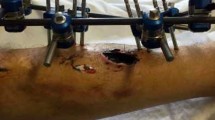Abstract
A prospective, randomized study was performed in 559 patients to compare two doses of oral cefadroxil with three doses of intravenous cefuorxime as antibiotic prophylaxis in intra- and subtrochanteric hip fracture surgery. Antibiotic concentrations in the wound fluid were determined at the start and at the end of the operation. The first dose of cefadroxil was given about 2 h before surgery and cefuroxime about 30 min before operation. In 226/242 (93%) patients randomized to oral cefadroxil, the concentration in the wound during surgery was on average 15 /gmg/ml, i.e., well above the minimum inhibitory concentration (MIC-90) for Staphylococcus aureus. In the cefuroxime group, antibiotic levels in the wound exceeded the MIC-90 for S. aureus in 204/210 (97%) of the patients at the start and/or at the end of surgery. All patients were followed up for 4 months. One deep and five superficial infections occurred in the cefuroxime group and no deep but one superficial infection in the cefadroxil group (P = 0.07). S. aureus was cultured in three of the infected cases while cultures were negative in four patients. Four of the seven infected patients had adequate levels of antibiotic in the wound during surgery, and in three patients no antibiotic assay was performed. The infected patients did not differ in age, sex, operation time, bleeding or any other basic variable compared with patients who healed without complications. Two doses of cefadroxil seems to be practical and as effective as intravenously administered cefuroxime as antibiotic prophylaxis in trochanteric hip fracture surgery.
Similar content being viewed by others
References
Barza M, Weinstein L (1974) Penetration of antibiotics into fibrin loci in vivo. Comparison of penetration of ampicillin into fibrin clots, abscesses and “interstitial” fluids. J Infect Dis 59:129
Bergan T (1987) Pharmacokinetic properties of cephalosporins. Drugs 34 [Suppl 2]:89–104
Bodoky A, Neff U, Heberer M, Harder F (1993) Antibiotic prophylaxis with two doses of cephalosporin in patients managed with internal fixation for a fracture of the hip. J Bone Joint Surg [Am] 75:61–65
Bowers WH, Wilson FC, Green WB (1973) Antibiotic prophylaxis in experimental bone infections. J Bone Joint Surg [Am] 55:795–807
Burnett JW, Gustillo RB, Williams DN, Kind AC (1980) Prophylactic antibiotics in hip fractures. A double blind prospective study. J Bone Joint Surg [Am] 62:457–462
Cars O (1980) Antibiotic assay in muscles: are conventional tissue levels misleading as indicator of antibacterial activity? Scand J Infect Dis 12:307–309
Garcia S, Lozano ML, Gatell JM, Soriano E. Ramon R, Sanmiguel JG (1991) Prophylaxis against infection. Single-dose cefonicid compared with multiple-dose cefamandole. J Bone Joint Surg [Am]: 73:1044–1048
Hamilton-Miller JM (1987) Microbial investigations of cephalosporins. Drugs 34 [Suppl 2]:23–43
Hedin G, Hambraeus A (1993) Daily scrub with chlorhexidine reduces skin colonization by antibiotic-resistant Staphylococci epidermidis. J Hosp Infect 24:47–61
Hedström S-TA, Lidgren L, Sernbo I, Törholm C, Onnerfdlt R (1987) Cefuroxime prophylaxis in trochanteric hip fracture operations. Acta Orthop Scand 58:361–364
Hjortrup A, Sørensen C, Mejdahl S, Horsnces M, Kjersgaard P (1990) Antibiotic prophylaxis in surgery for hip fractures. Acta Orthop Scand 61:152–153
Jalling M, Malmborg AS, Boreus LO (1972) Evaluation of a micromethod for determination of antibiotic concentrations in plasma. Eur J Clin Pharmacol 4:150
Jones S, DiPiro JT, Nix DE, Bhatti NA (1985) Cephalosporins for prophylaxis in operative repair of femoral fractures: levels in serum, muscle, and haemtoma. J Bone Joint Surg [Am] 67:921–924
Kleeman KT, Tammy B, Wesley EK (1993) Species distribution of coagulase-negative staphylococcal isolates at a community hospital and implication for selection of staphylococcal identification procedures. J Clin Microbial 31:1318–1321
Knapp CC, Washington JA (1988) In vitro activities of LY 163892, cefaclor and Cefuroxime. Antimicrob Agents Chemother 32:131–133
Lindberg L (1984) Antibiotic prophylaxis in postoperative infections in orthopaedic surgery. In: Antibiotics and surgery workshop. National Board of Health and Welfare, Sweden, pp 59–65
Lorian V (1975) Some effects of subinhibitory concentrations of penicillin on the structure and division of staphylococci. Antimicrob Agents Chemother 7:864–870
McDonald PJ, Wetherall BL, Pruul H (1981) Postantibiotic leukocyte enhancement: increased susceptibility of bacteria pretreated with antibiotics to activity of leukocytes. Rev Infect Dis 3:33–44
Neu HC (1984) Cephalosporin antibiotics as applied in surgery of bones and joints. Clin Orthop 190:50–64
Nungu KS, Bengtsson S, Olerud C, Rehnberg L, Larsson S (1992) Oral cephadroxil prophylaxis in hip fracture surgery. Acta Orthop Scand 63:4–6
Quintiliani R (1982) A review of the penetration of cefadroxil into human tissue. J Antimicrob Chemother 10[Suppl B]:33–38
Quintiliani R, Nightingale C (1984) Principals of antibiotic usage. Clin Orthop 190:31–35
Ryan DM (1979) Implanted cotton threads: a novel method for measuring concentrations of antibiotics in tissue fluids. J Antimicrob Chemother 5:735
Schurman DJ, Hirshman HP, Burton HP (1980) Cefalotin and cefamandole penetration into bone synovial fluid, and wound drainage fluid. J Bone Joint Surg [Am] 62:981–985
Shah PM, Heetderks G, Stille W (1976) Activity of amikacin at subinhibitory levels. J Antimicrob Chemother 2:97–100
Sheppard M, King A, Phillips I (1991) In vitro activity of cefpodoxime, a new oral cephalosporin, compared with that of nine other antimicrobial agents. Eur J Clin Micro Infect Dis 10:573–581
Tengve B, Kjellander J (1978) Antibiotic prophylaxis in operations on trochanteric femoral fractures. J Bone Joint Surg [Am] 60:97–99
Author information
Authors and Affiliations
Rights and permissions
About this article
Cite this article
Nungu, K.S., Olerud, C., Rehnberg, L. et al. Prophylaxis with oral cefadroxil versus intravenous cefuroxime in trochanteric fracture surgery. Arch Orthop Trauma Surg 114, 303–307 (1995). https://doi.org/10.1007/BF00448952
Received:
Issue Date:
DOI: https://doi.org/10.1007/BF00448952




